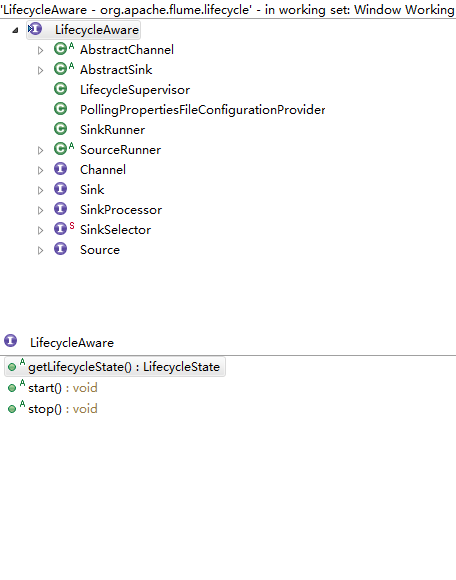flume-ng 启动过程源码分析
2015-10-29 00:00
483 查看
通过bin/flume-ng 脚本可以看到Flume启动的入口是org.apache.flume.node.Application类,那么就从Application类开始研究。
读取命令行参数,f指定配置文件,n指定agent name ,no-reload-conf 参数决定是否采用动态加载配置文件,若没有配置,reload为true,采用动态加载,否则只加载一次。
实现动态加载功能采用了发布订阅模式,使用guava中的EventBus实现。
关于EventBus可以参考:http://my.oschina.net/u/2311010/blog/515188
接下来继续看EventBus是如何实现动态加载的。
LifecycleAware生命周期组件,有start(),stop(),getLifecycleState()三个方法,source,channel,sink都实现了该接口

components.add(configurationProvider);添加PollingPropertiesFileConfigurationProvider对象,目前components只添加了一个对象,并作为参数传递给Application的构造方法,接下来看下Application的start()。
supervise 方法会对 component 创建一个 MonitorRunnable 进程,并放入默认有10个线程的 monitorService 去执行
接下来看MonitorRunnable的run(),根据supervisoree.status.desiredState的状态去调用lifecycleAware的start或者stop方法,此处的lifecycleAware就是PollingPropertiesFileConfigurationProvider对象
PollingPropertiesFileConfigurationProvider的start()创建一个单线程,每隔30s执行FileWatcherRunnable的run方法。
如果配置文件最后的修改时间晚于文件上次的修改时间,则会调用eventBus.post(getConfiguration());
getConfiguration()会读取配置文件,把sources,channel,sink相信的配置信息保存在SimpleMaterializedConfiguration对象中,并返回
eventBus.post(getConfiguration())会调用Application 的handleConfigurationEvent方法
其中stopAllComponents()用来停止正在运行的组件,顺序是:source、sink、channel,这样可以避免停止组件导致的数据丢失。
startAllComponents(conf)会根据返回的配置文件内容启动所有组件,启动顺序正好于停止顺序相反
启动组件会调用supervisor.supervise()方法,supervise方法会调用对应的lifecycleAware的start()方法。
flume的启动和动态加载就已经分析完毕了
CommandLineParser parser = new GnuParser();
CommandLine commandLine = parser.parse(options, args);
File configurationFile = new File(commandLine.getOptionValue('f'));
String agentName = commandLine.getOptionValue('n');
boolean reload = !commandLine.hasOption("no-reload-conf");读取命令行参数,f指定配置文件,n指定agent name ,no-reload-conf 参数决定是否采用动态加载配置文件,若没有配置,reload为true,采用动态加载,否则只加载一次。
List<LifecycleAware> components = Lists.newArrayList();
Application application;
if(reload) {
EventBus eventBus = new EventBus(agentName + "-event-bus");
PollingPropertiesFileConfigurationProvider configurationProvider =
new PollingPropertiesFileConfigurationProvider(agentName,
configurationFile, eventBus, 30);
components.add(configurationProvider);
application = new Application(components);
eventBus.register(application);
} else {
PropertiesFileConfigurationProvider configurationProvider =
new PropertiesFileConfigurationProvider(agentName,
configurationFile);
application = new Application();
application.handleConfigurationEvent(configurationProvider.getConfiguration());
}
application.start();实现动态加载功能采用了发布订阅模式,使用guava中的EventBus实现。
关于EventBus可以参考:http://my.oschina.net/u/2311010/blog/515188
接下来继续看EventBus是如何实现动态加载的。
LifecycleAware生命周期组件,有start(),stop(),getLifecycleState()三个方法,source,channel,sink都实现了该接口

components.add(configurationProvider);添加PollingPropertiesFileConfigurationProvider对象,目前components只添加了一个对象,并作为参数传递给Application的构造方法,接下来看下Application的start()。
public synchronized void start() {
for(LifecycleAware component : components) {
supervisor.supervise(component,
new SupervisorPolicy.AlwaysRestartPolicy(), LifecycleState.START);
}
}//此处的component 就是上面的PollingPropertiesFileConfigurationProvider对象supervise 方法会对 component 创建一个 MonitorRunnable 进程,并放入默认有10个线程的 monitorService 去执行
Supervisoree process = new Supervisoree(); process.status = new Status(); process.policy = policy; process.status.desiredState = desiredState; process.status.error = false; MonitorRunnable monitorRunnable = new MonitorRunnable(); monitorRunnable.lifecycleAware = lifecycleAware; monitorRunnable.supervisoree = process; monitorRunnable.monitorService = monitorService; supervisedProcesses.put(lifecycleAware, process); ScheduledFuture<?> future = monitorService.scheduleWithFixedDelay( monitorRunnable, 0, 3, TimeUnit.SECONDS); //定时调度MonitorRunnable monitorFutures.put(lifecycleAware, future); //MonitorRunnable返回的结果保存到monitorFutures
接下来看MonitorRunnable的run(),根据supervisoree.status.desiredState的状态去调用lifecycleAware的start或者stop方法,此处的lifecycleAware就是PollingPropertiesFileConfigurationProvider对象
public void start() {
LOGGER.info("Configuration provider starting");
Preconditions.checkState(file != null,
"The parameter file must not be null");
executorService = Executors.newSingleThreadScheduledExecutor(
new ThreadFactoryBuilder().setNameFormat("conf-file-poller-%d")
.build());
FileWatcherRunnable fileWatcherRunnable =
new FileWatcherRunnable(file, counterGroup);
executorService.scheduleWithFixedDelay(fileWatcherRunnable, 0, interval,
TimeUnit.SECONDS);
lifecycleState = LifecycleState.START;
LOGGER.debug("Configuration provider started");
}PollingPropertiesFileConfigurationProvider的start()创建一个单线程,每隔30s执行FileWatcherRunnable的run方法。
public void run() {
LOGGER.debug("Checking file:{} for changes", file);
counterGroup.incrementAndGet("file.checks");
long lastModified = file.lastModified();
if (lastModified > lastChange) {
LOGGER.info("Reloading configuration file:{}", file);
counterGroup.incrementAndGet("file.loads");
lastChange = lastModified;
try {
eventBus.post(getConfiguration());
} catch (Exception e) {
LOGGER.error("Failed to load configuration data. Exception follows.",
e);
} catch (NoClassDefFoundError e) {
LOGGER.error("Failed to start agent because dependencies were not " +
"found in classpath. Error follows.", e);
} catch (Throwable t) {
// caught because the caller does not handle or log Throwables
LOGGER.error("Unhandled error", t);
}
}
}如果配置文件最后的修改时间晚于文件上次的修改时间,则会调用eventBus.post(getConfiguration());
getConfiguration()会读取配置文件,把sources,channel,sink相信的配置信息保存在SimpleMaterializedConfiguration对象中,并返回
public MaterializedConfiguration getConfiguration() {
MaterializedConfiguration conf = new SimpleMaterializedConfiguration();
FlumeConfiguration fconfig = getFlumeConfiguration();
AgentConfiguration agentConf = fconfig.getConfigurationFor(getAgentName());
if (agentConf != null) {
Map<String, ChannelComponent> channelComponentMap = Maps.newHashMap();
Map<String, SourceRunner> sourceRunnerMap = Maps.newHashMap();
Map<String, SinkRunner> sinkRunnerMap = Maps.newHashMap();
try {
loadChannels(agentConf, channelComponentMap);
loadSources(agentConf, channelComponentMap, sourceRunnerMap);
loadSinks(agentConf, channelComponentMap, sinkRunnerMap);
Set<String> channelNames =
new HashSet<String>(channelComponentMap.keySet());
for(String channelName : channelNames) {
ChannelComponent channelComponent = channelComponentMap.
get(channelName);
if(channelComponent.components.isEmpty()) {
LOGGER.warn(String.format("Channel %s has no components connected" +
" and has been removed.", channelName));
channelComponentMap.remove(channelName);
Map<String, Channel> nameChannelMap = channelCache.
get(channelComponent.channel.getClass());
if(nameChannelMap != null) {
nameChannelMap.remove(channelName);
}
} else {
LOGGER.info(String.format("Channel %s connected to %s",
channelName, channelComponent.components.toString()));
conf.addChannel(channelName, channelComponent.channel);
}
}
for(Map.Entry<String, SourceRunner> entry : sourceRunnerMap.entrySet()) {
conf.addSourceRunner(entry.getKey(), entry.getValue());
}
for(Map.Entry<String, SinkRunner> entry : sinkRunnerMap.entrySet()) {
conf.addSinkRunner(entry.getKey(), entry.getValue());
}
} catch (InstantiationException ex) {
LOGGER.error("Failed to instantiate component", ex);
} finally {
channelComponentMap.clear();
sourceRunnerMap.clear();
sinkRunnerMap.clear();
}
} else {
LOGGER.warn("No configuration found for this host:{}", getAgentName());
}
return conf;
}eventBus.post(getConfiguration())会调用Application 的handleConfigurationEvent方法
public synchronized void handleConfigurationEvent(MaterializedConfiguration conf) {
stopAllComponents();
startAllComponents(conf);
}其中stopAllComponents()用来停止正在运行的组件,顺序是:source、sink、channel,这样可以避免停止组件导致的数据丢失。
startAllComponents(conf)会根据返回的配置文件内容启动所有组件,启动顺序正好于停止顺序相反
private void startAllComponents(MaterializedConfiguration materializedConfiguration) {
logger.info("Starting new configuration:{}", materializedConfiguration);
this.materializedConfiguration = materializedConfiguration;
for (Entry<String, Channel> entry :
materializedConfiguration.getChannels().entrySet()) {
try{
logger.info("Starting Channel " + entry.getKey());
supervisor.supervise(entry.getValue(),
new SupervisorPolicy.AlwaysRestartPolicy(), LifecycleState.START);
} catch (Exception e){
logger.error("Error while starting {}", entry.getValue(), e);
}
}
/*
* Wait for all channels to start.
*/
for(Channel ch: materializedConfiguration.getChannels().values()){
while(ch.getLifecycleState() != LifecycleState.START
&& !supervisor.isComponentInErrorState(ch)){
try {
logger.info("Waiting for channel: " + ch.getName() +
" to start. Sleeping for 500 ms");
Thread.sleep(500);
} catch (InterruptedException e) {
logger.error("Interrupted while waiting for channel to start.", e);
Throwables.propagate(e);
}
}
}
for (Entry<String, SinkRunner> entry : materializedConfiguration.getSinkRunners()
.entrySet()) {
try{
logger.info("Starting Sink " + entry.getKey());
supervisor.supervise(entry.getValue(),
new SupervisorPolicy.AlwaysRestartPolicy(), LifecycleState.START);
} catch (Exception e) {
logger.error("Error while starting {}", entry.getValue(), e);
}
}
for (Entry<String, SourceRunner> entry : materializedConfiguration
.getSourceRunners().entrySet()) {
try{
logger.info("Starting Source " + entry.getKey());
supervisor.supervise(entry.getValue(),
new SupervisorPolicy.AlwaysRestartPolicy(), LifecycleState.START);
} catch (Exception e) {
logger.error("Error while starting {}", entry.getValue(), e);
}
}
this.loadMonitoring();
}启动组件会调用supervisor.supervise()方法,supervise方法会调用对应的lifecycleAware的start()方法。
flume的启动和动态加载就已经分析完毕了
相关文章推荐
- 从源码安装Mysql/Percona 5.5
- BootISO:从 ISO 文件中创建一个可启动的 USB 设备
- 路由器启动的顺序
- 浅析Ruby的源代码布局及其编程风格
- 免安转MySQL服务的启动与停止方法
- C#实现开机自动启动设置代码分享
- VC++实现程序开机启动运行的方法
- asp.net 抓取网页源码三种实现方法
- JS小游戏之仙剑翻牌源码详解
- JS小游戏之宇宙战机源码详解
- jQuery源码分析之jQuery中的循环技巧详解
- 本人自用的global.js库源码分享
- Oracle监听器服务不能启动的解决方法
- 使用VBS禁用、启动USB存储设备
- windows下如何安装和启动MySQL
- java中原码、反码与补码的问题分析
- C#实现将应用程序设置为开机启动的方法
- ip修改后orcale服务无法启动问题解决
- 使用批处理实现启动和停止服务的代码分析(net start&net stop)
- 计算机名称修改后Oracle不能正常启动问题分析及解决
